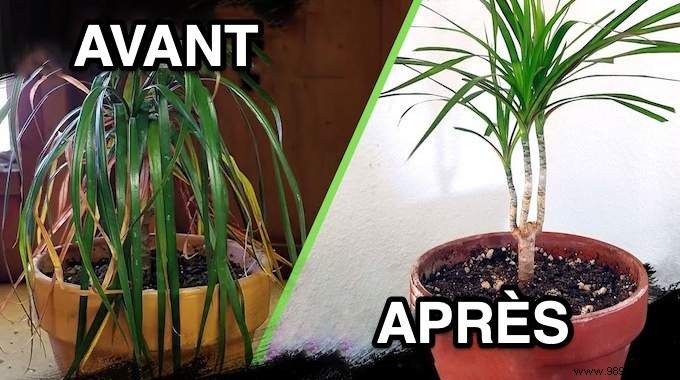
You just got home, and your plant is dying ?
Don't panic, because hopefully it's not too late!
Even when a houseplant looks completely dead, it may not be!
But then, how to save and recover a dead plant?
The first thing most people do is water it.
However, one of the most common mistakes is to drown a plant, because too much water can make the situation worse!
Thus, before saving a plant, one must first understand the causes of its decline.
Here are 4 gardening secrets to save a dead plant and get it going again . Watch:

Click here to easily print this guide in PDF.

The answer is yes!
As long as the roots are still alive, he hopes to see your plant reborn.
Healthy, white roots are a sign that your plant still has a chance to come back to life.
Even better, try scraping the base of the stem to remove the dried bark.
If the inside of the stem is still green, there is still a sign of life.
The first step is to get rid of the dead parts of the plant.
Using pruners, cut off dead leaves and tops of stems, especially if the roots are damaged.
Start at the top and cut off anything brown, dry, and dead.
Stop as soon as you see green inside the stem, as that means you are on a living part of the plant.
With fewer dead stems, the roots are less stressed, and they will be able to recover more quickly.
And with any luck, new stems will soon appear on the cut stems.
Now that the dead stems have been cut, you can proceed to the "diagnosis" of your plant.
Here are all the symptoms and dangers you should know about, and most importantly, gardener's secrets to resuscitating a dead plant . Watch:
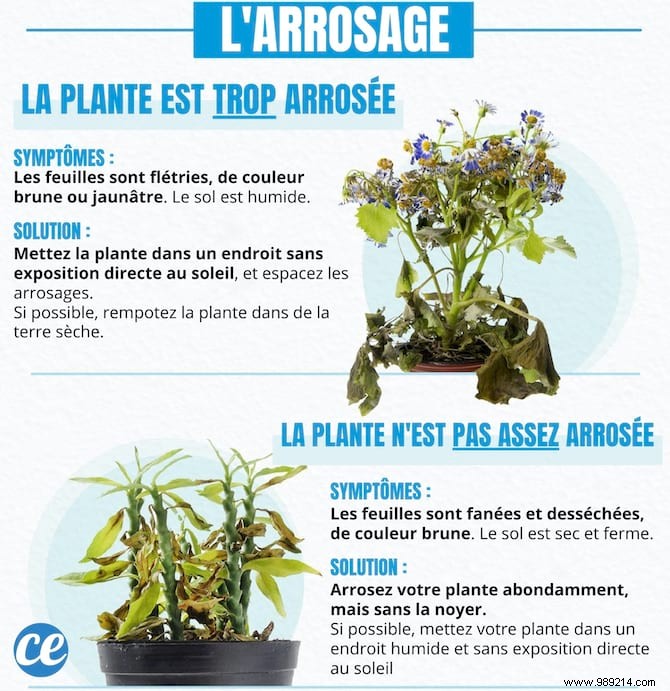
The plant is too watered
Symptoms: leaves are withered, brown or yellowish in color; the ground is wet.
Solution: place the plant in a place without direct exposure to the sun, and space out the waterings. If possible, repot the plant in dry soil.
The plant is not enough watered
Symptoms: the leaves are withered and withered, brown in color; the ground is dry and firm.
Solution: water your plant, don't drown it. Put it in a sink, fill the pot and wait for the excess water to drain. If possible, put your plant in a humid place without direct sunlight.
If you water your plant too often, its stems will become limp and withered.
Its leaves will also turn brown and yellowish.
If this is the case, do not add any fertilizer or nutrient sticks to the soil until you are 100% sure that your plant is well restored.
Indeed, particularly sensitive, the roots need time to heal.
Similarly, place an over-watered plant in a location out of direct sunlight.
And take care to space out the waterings until its roots have recovered.
You'll know your plant is fully recovered when its leaves have returned to their green color, and the soil is neither too wet nor too firm.
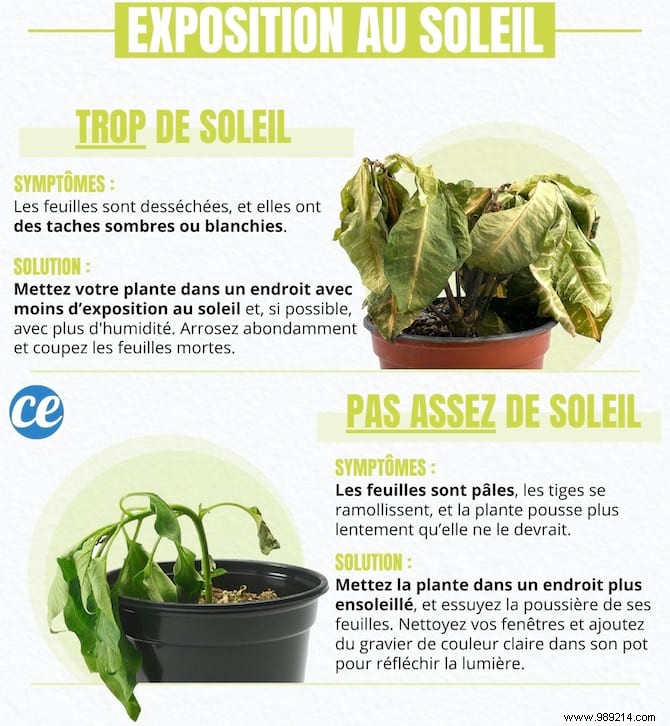
The plant receives too much sun
Symptoms: leaves are withered, and have dark or white spots.
Solution: place your plant in a location with less sun exposure and, if possible, more humidity. Water thoroughly and cut off dead leaves.
The plant does not receive enough sun
Symptoms: the leaves are pale, its stems are softening, the plant stops growing or grows more slowly than it should.
Solution: put it in a sunnier spot, and wipe the dust off the leaves. Clean your windows and add gravel or light colored clay pebbles to its pot, to reflect the light.
Each plant is unique, and reacts differently to the sun.
Some plants need a lot of light, while others can't stand direct sunlight.
So a sudden change in a plant's light can put your plant into shock.
For example, changing the location of your plant or putting up curtains in the room.
In general, the ideal brightness should be high, without being too direct.
To find out the specific needs of your plant in terms of sunlight, you can inquire at a garden centre.
That way, you'll know exactly how much sun she wants, and find the perfect spot in your home for her to thrive.
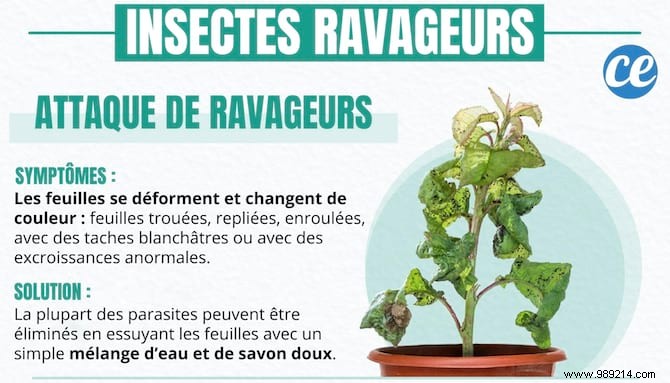
The plant is attacked by insect pests
Symptoms: leaves become deformed and change color:leaves with holes, folded, curled, with whitish spots or abnormal growths.
Solution: most pests can be removed by wiping the leaves with a simple mixture of mild soap and water.
A plant is never safe from an attack by insect pests.
Fortunately, most of these pests are easy to fight and eliminate.
In particular, you can plant repellent plants around your other plants to protect them from an invasion.
Click here to discover the plants that protect your home from insects.
If the leaves change color or shape, they are attacked by insect pests that suck the sap from your plants.
And if your plant is no longer growing as it should, it could be a sign that insects are hiding there and nibbling on it.
The larvae of certain insects can also cause damage and cause growths to appear on the leaves of plants.
To discover: 12 Super Effective And Natural Tips To Say Goodbye To Aphids Quickly.
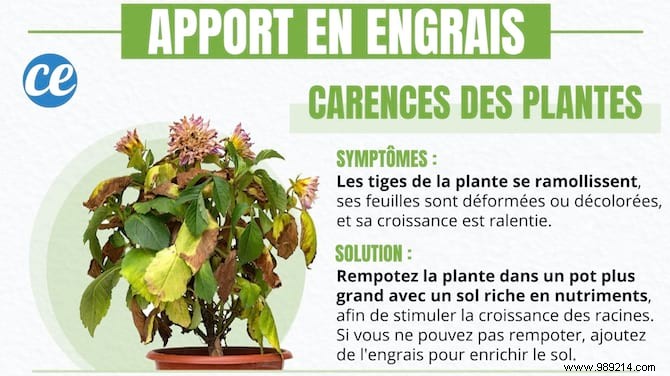
The plant has a deficiency
Symptoms: the plant's stems soften, its leaves become distorted or discolored, and its growth is stunted.
Solution: repot the plant in a larger pot with nutrient-rich soil to stimulate root growth. If you can't repot, add fertilizer or a nutrient packet to enrich the soil.
As with humans and animals, plants also need food.
Without a fertilizer supply, your plant does not have enough nutrients to feed itself, and its growth will slow down.
Fortunately, you can easily make your own homemade fertilizer with products you already have at home, which contains all the nutrients your plant needs.
Click here to discover the 7 best do-it-yourself fertilizers for the garden.
If, despite your best efforts, your plant does not recover, do not throw it away!
Instead of putting it in the trash, you can put its remains in the compost.
Thus, its nutrients will be beneficial to the growth of your other plants.
And be aware that reviving a plant, it takes time!
It takes several weeks or even months for your plant to fully recover.
So be patient, and monitor your plant's progress closely during this recovery period!
By giving it some well-deserved care, your plant will become happier, greener and full of vitality.
After saving your plant, be sure to monitor its light, water, and fertilizer needs to keep it healthy.
And why not find him some new plants to keep him company and help him recover?
Not sure which plant to choose? Click here for the guide to the best houseplants.